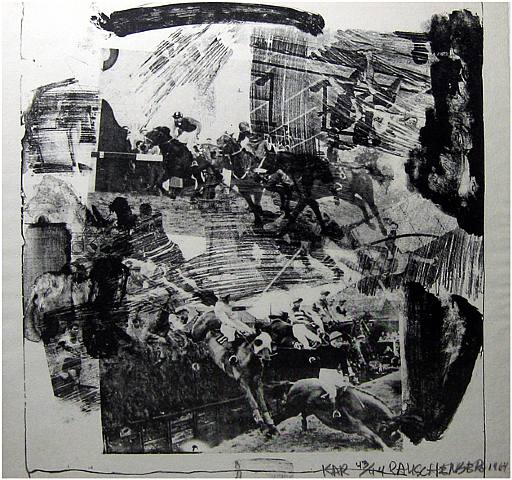Rauschenberg had decided to become an artist after an unsuccessful time studying pharmacology and enrolling into the US Navy during world War II. His educational background was very extensive. After getting a typical art education at the Kansis City Art Institute, Robert studied abroad at the Academie Julian in Paris which helped broaden his worldly view. There he met his future wife Susan Weil, also an artist, whose work was similar in terms of combining pictures in an abstract way, yet was not nearly as developed as her husband.
 |
| Sample of Susan Veil's work. |
Upon returning to the United States, Robert studied at Black Mountain College in North Carolina. The education was very different than his previous courses. Earlier on in his education, the goal was to paint only under the influence of great master and to develop a classical style. Albers, a professors at Black Mountain, taught Robert to do the exact opposite of what he knew and to develop his own style. Robert discovered that art was all about experimentation and self discovery. In 1951, Robert had his own solo exhibition at the Betty Parsons Gallery in New York. The focus of this show was a new series of paintings call the white, black and red paintings. The white paintings were monochromatic and there purpose was to "reduce painting to its most essential nature." Anyone viewing these paintings would think it was a displayed blank canvas with no art on it. When thought about a little further, the blank canvas becomes complex based on its surroundings. Light and shadow bounce off the canvas depending on people around it. " The smallest adjustment of light is registered on the surface." This blank canvas is in fact not blank at all when contrasted with the real world. Its an ever changing work of art.

The black paintings incorporated newsprint and were painted upon to let sections of the paper peek out from underneath. It had multiple panels of different shades of black.
The red paintings were applied with different painting techniques for texture and variation. He would include other objects such as newsprint, wood and nails. This was the beginning stages for his "Combines" which included found objects that were renewed in meaning by its context.
In 1958, Robert spent two and a half years creating a project based on the 34 Cantus of Dante's Inferno. He took magazine photos and solvent transfer techniques to create his own drawings.
In the 1960's, Robert played around with different mediums. In addition to the use of found objects, he tried printmaking and performance art. He would take photographs and silk screen them onto his paintings. Many of the images had to deal with the lifestyle and politics of the 1960's. He was called a Pop artist and related to Andy Warhol for his use of recognizable symbols being recreated in different colors and repeated.
This painting reveals the essence of the 1960's with the use of John F. Kennedy, who is prominent in many of Robert's works, and the expansion of the human race through space travel, inventions and equal rights. He captured most things that made the 60's what it was known for while including an interesting perspective with colorful images.







No comments:
Post a Comment